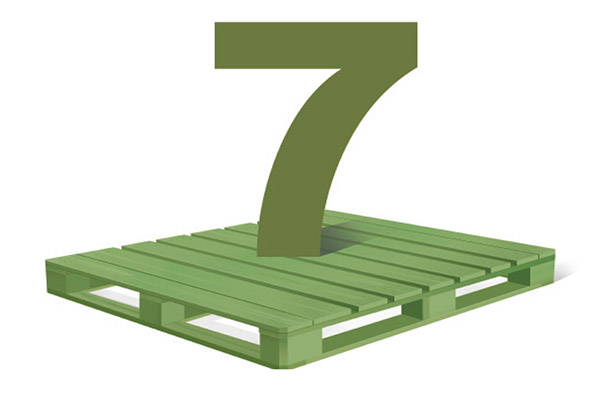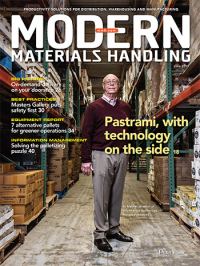Seven alternative pallets for greener operations
Alternative materials and hybrid combinations in pallets target improved sustainability.
As more companies take a closer look at improving their sustainability practices, pallet usage has come under increased scrutiny. While Virginia Tech researchers found that 95% of wooden pallets are recycled domestically, an estimated 50% of the annual U.S. hardwood harvest is dedicated to their production. Although reforestation efforts have achieved a ratio of two new trees planted for each one harvested, it still takes years for new plantings to reach maturity.
Further, the ability to reuse plastic pallets hundreds of times over is frequently cited as a reason to invest in them. Yet they too have potential drawbacks, including cost, their hydrocarbon material source and the energy required to mold each pallet.
To address these concerns, several manufacturers are responding with pallets made from alternative materials or hybrid combinations of typical materials. These unique pallets offer a variety of sustainability advantages—and other benefits—explored in this article.
1.) Engineered molded wood deters pests
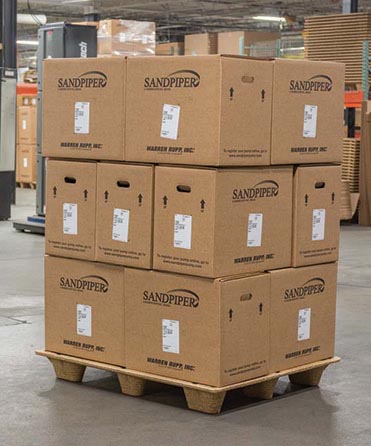
Litco International’s INCA Engineered Molded Wood pallets are compression molded to create a high-density material from wood fibers and a bonding substance.
Litco International’s INCA Engineered Molded Wood pallets are compression molded under high heat and pressure to create a high-density material from wood fibers and a bonding substance. While the pallets’ primary purpose is to protect products in transport, sustainability is also a critical key to their manufacture, says Gary Sharon, executive vice president.
“We use a mixture of hard and softwood chips sourced from pre- and post-consumer wood waste,” Sharon explains. “They’re a USDA Certified BioBased Product because they use more than 97% renewable, plant-based materials, and Certified Sustainable by the Cradle to Cradle Products Innovation Institute.”
To cut transport costs, 50 pallets nest in a 7-foot-high space. They come in 10 sizes, including GMA and Euro, with load ratings from light to extra heavy duty. Fastener-free, they don’t puncture bagged products, and they are priced between new/custom made and used/rebuilt solid wood pallets. They’re also dimensionally consistent and withstand multiple closed-loop trips.
“Because they can’t be repaired, they’re ideal for one-way and export shipping,” adds Sharon, who notes that per the International Standards for Phytosanitary Measures (ISPM) 15, the pallets are pest-free processed wood. “Because the wood fiber dries to a 3% moisture content during processing, they resist mold in high humidity environments and don’t attract moisture sensing pests.”
2.) Recyclable corrugated saves shipping costs
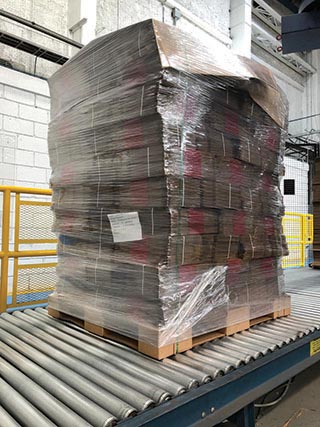
Industrial-strength corrugated pallets from Green Ox are rated up to 2,000 pounds capacity and are fully recyclable.
Fully recyclable, industrial-strength corrugated pallets from Green Ox Pallet Technology are rated up to 2,000 pounds capacity—but have been tested by sea and air to hold in excess of 2,500 pounds, says Adam Pener, president.
Intended for one-way use, the pallet was engineered to cut costs. They ship flat for assembly at the point of use, and then are machine or hand folded. Glue can be applied for additional strength, as can optional water-retardant coating—neither impacts recyclability. They’re also ISPM-15 exempt, eliminating heat treatment costs.
“Further, they optimize space, strength, dimensions and delivery at 50% to 80% lower weight than wood or plastic, driving savings and efficiencies,” Pener says. “In addition to high dollar savings, downstream customers are happier because they can recycle our pallet rather than paying to dispose of wood or plastic.”
The corrugated pallets are manufactured in a variety of sizes and are ideal for air shipping electronics and produce. “Although it depends on paper strength, volume and dimensions for high-volume exporters, unit cost is typically less than wood or plastic before factoring in the other savings,” Pener adds.
3.) Coating leverages best properties of wood, plastic
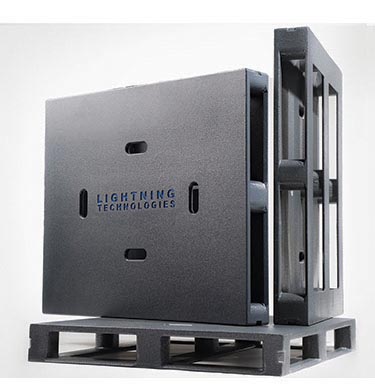
The hybrid Lightning pallet from Lightning Technologies is engineered plywood sourced from sustainable plantations.
Made of engineered plywood sourced from sustainable plantations and sporting a 1-millimeter-thick coating of proprietary ExoBond polyurea, the hybrid Lightning pallet from Lightning Technologies is anticipated to last for a decade, says Jeffrey Owen, founder and CEO. “That vastly exceeds standard wood pallets that have an average of 11 turns,” he says.
That coating renders the pallet extremely durable, lightweight, fire-retardant, sustainable, hygienic, skid-free, easily sanitized, repairable and with the option to include antimicrobial additives. Offered in standard and custom sizes through a pooled leasing program, each pallet also has an embedded active radio-frequency identification device (RFID). That feature makes it particularly ideal for shippers of perishables, pharmaceuticals, and high-value or sensitive products like electronics, Owen adds.
“Ours is the only pallet in the market with an active RFID that continuously sends data about critical factors to a Cloud-based dashboard,” Owen explains. “Users determine the threshold for temperature, humidity, time in transit, impacts, shelf life and location. The dashboard displays the readings in real time, highlighting any pallet that deviates from their settings.”
Having such information facilitates track and trace, allows more targeted recalls and protects brands, Owen adds. “Retailers can use the data to prioritize stocking and replenishment with items whose shelf life is the shortest. And, sellers of expensive or sensitive items can be instantly alerted to a damaging impact or a shipment that wanders off its intended route, indicating potential theft.”
4.)Wood capped with impact resistant bumpers
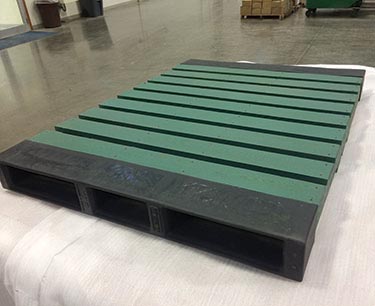
Green Line Armor’s fully recyclable Hybrid Sustained Use Pallet combines the strength of hardwood stringers with impact-resistant polypropylene bumpers.
Combining the strength of hardwood stringers with impact-resistant polypropylene bumpers is Green Line Armor’s fully recyclable Hybrid Sustained Use Pallet (SUP). Not only are bio-composite bumpers molded under extreme pressure for high strength and durability, says Nick Lansing, president, they’re also used in place of lead boards—where 90% of pallet damage occurs.
“We came up with this hybrid concept specifically to meet a customer’s request for a solution to stop lead board damage,” Lansing explains. “Then we realized the pallet’s ability to address corporate initiatives for sustainability and reduced carbon footprints. Our goal was to produce a pallet that eliminated all prior issues, that companies could buy once and use forever.”
Alloy screw assembled to prevent nail pops, the wood is stained with a special formulation for mold, mildew and UV-ray protection, as well as to resist marring and other contaminants. The standard 48 x 40-inch footprint comes in four-way/three-stringer or two-way/four-stringer configurations, and custom sizes can be specified. Dimensionally consistent, the SUP works with automation and includes dual EPC Gen2 RFID tags for traceability.
Rated to 12,000 pounds rackable strength, the SUP is ideal for ultra-heavy, dense loads and in closed-loop systems, Lansing says. “For example, a canned goods customer uses it to stack loads of heat-sealed soup cans up to six pallets high for cooling prior to labeling. Their previous plastic pallets failed due to the heat and the pressure,” he says.
5.) Corrugated wrapped, glued to wood skeleton
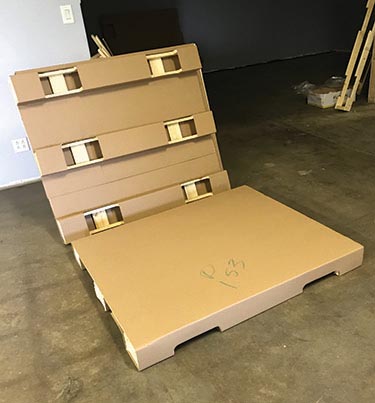
The NextPallet is constructed of recycled corrugated and heat treated softwood, held together with industrial adhesive.
Not yet on the market, the NextPallet is offered in a geographically exclusive licensed technology format to existing wood pallet sellers who will assemble, sell and deliver it to customers, explains Tod Ginnis, president of the start-up. The pallet is constructed of recycled corrugated and heat-treated softwood, held together with an industrial adhesive. This makes it lighter than wood pallets, yielding shipping and fuel savings in alignment with corporate sustainability goals.
“Pallet users have been looking for ways to replace wood for years,” Ginnis says. “But alternatives have always left firms with the choice of making a compromise—such as higher cost, or lower load-bearing and racking capacity—or sticking with wood. Our patented design yields a solution that can haul and rack the loads like a wood pallet but weighs far less.”
The current model is GMA sized, but custom sizes will also be offered. Priced competitively with wood pallets, the NextPallet can also be RFID tagged and custom printed with logos, instructions or bar codes. Ginnis says ideal markets include air freight, less-than-truckload, and those who are charged by shipment weight, as well as full-truckload and container shippers who can load more product before maxing out.
6.) Custom construction solves unique challenges
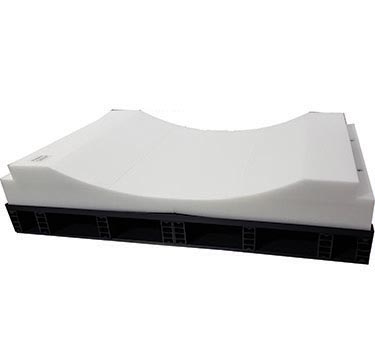
Custom Built Plastic Pallets creates hybrid pallets from alternative materials to address customers’ specific challenges like this foam cradle to support roll handling.
Building pallets from a combination of 100% recycled, extruded polyvinylchloride (PVC) and other components—such as hardwood, aluminum and composites—Custom Built Plastic Pallets creates hybrid pallets from alternative materials to address customers’ specific challenges.
“Depending on what the user’s handling issue is, we utilize whatever material we feel will best address their problem,” explains Wayne Meyer, director of sales and marketing. “For one customer whose plastic pallets were failing under the pressure of their forklift’s clamper, we added a single hardwood stringer to enhance strength and rigidity. Likewise, we’ve done the same with composite materials.”
Another customer with a unique racking system requested a plastic pallet with an aluminum deckboard bottom, and a third needed an integrated foam cradle to support roll handling. To ensure the proposed solution is the right one, Meyer sends out a sample pallet for pilot testing and approval prior to full production—which ranges from one to 1,000, he says.
7.) Banana fiber blocks support sustainability
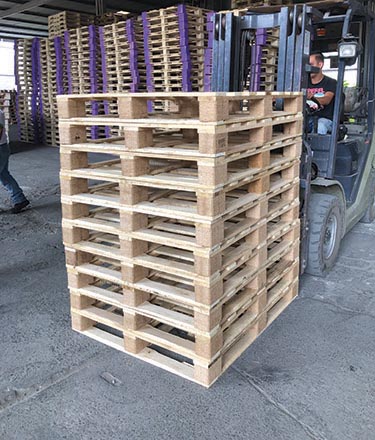
Yellow Pallet has begun shipping its first nine-block pallets made with engineered blocks comprised of banana fiber and resin.
With its first manufacturing plant coming online earlier this year in Costa Rica, Dutch start-up Yellow Pallet has begun shipping its first nine-block pallets made with engineered blocks comprised of banana fiber and resin. Initially targeting local fruit exporters, the blocks replace 30% of the wood volume of a pallet, says Hein van Opstal, founder.
“To export bananas, pineapples and melons worldwide, those companies use 4 million of the 5.7 million wood pallets produced here annually, with most of the pine imported from Chile an Melina wood coming from hundreds of kilometers away,” van Opstal explains.
“Our goal was to build a pallet that reduced deforestation and carbon footprints by putting the factory close to the source materials and customers, and by replacing wood for the blocks. A banana plantation produces four- to six-times the amount of fiber than a comparably sized wood forest.”
The banana plants used are a variety naturally resistant to disease, making the product fully organic. They grow to maturity in six months, when their stems are harvested, chopped up and air dried, milled and blended with a biodegradable resin, molded then cut into the block shape. Using them in place of wood reduces carbon emissions by 22% to 50%, notes van Opstal, who adds that by minimizing raw material and production costs, Yellow Pallets are also priced lower than their wood counterparts.

Article Topics
Shipping Pallets News & Resources
Two voices of reason on pallet materials Pallet recycler and services company PLA appoints Steve Clark as CEO Cobot as key ingredient for palletizing efficiency CHEP appoints Xavier Garijo to newly created CEO Americas position Pallet company Kamps announces executive team changes PLA names Jenny Bedard as new CFO Moving pallets at Aurobindo More Shipping PalletsLatest in Materials Handling
Registration open for Pack Expo International 2024 Walmart chooses Swisslog AS/RS and software for third milk processing facility NetLogistik partners with Vuzix subsidiary Moviynt to offer mobility solutions for warehouses Materials Handling Robotics: The new world of heterogeneous robotic integration BSLBATT is looking for new distributors and resellers worldwide Lucas Watson appointed CSO for Körber’s Parcel Logistics business in North America Hyster recognizes Dealers of Distinction for 2023 More Materials HandlingAbout the Author
Subscribe to Materials Handling Magazine

Find out what the world's most innovative companies are doing to improve productivity in their plants and distribution centers.
Start your FREE subscription today.
April 2024 Modern Materials Handling

Latest Resources


